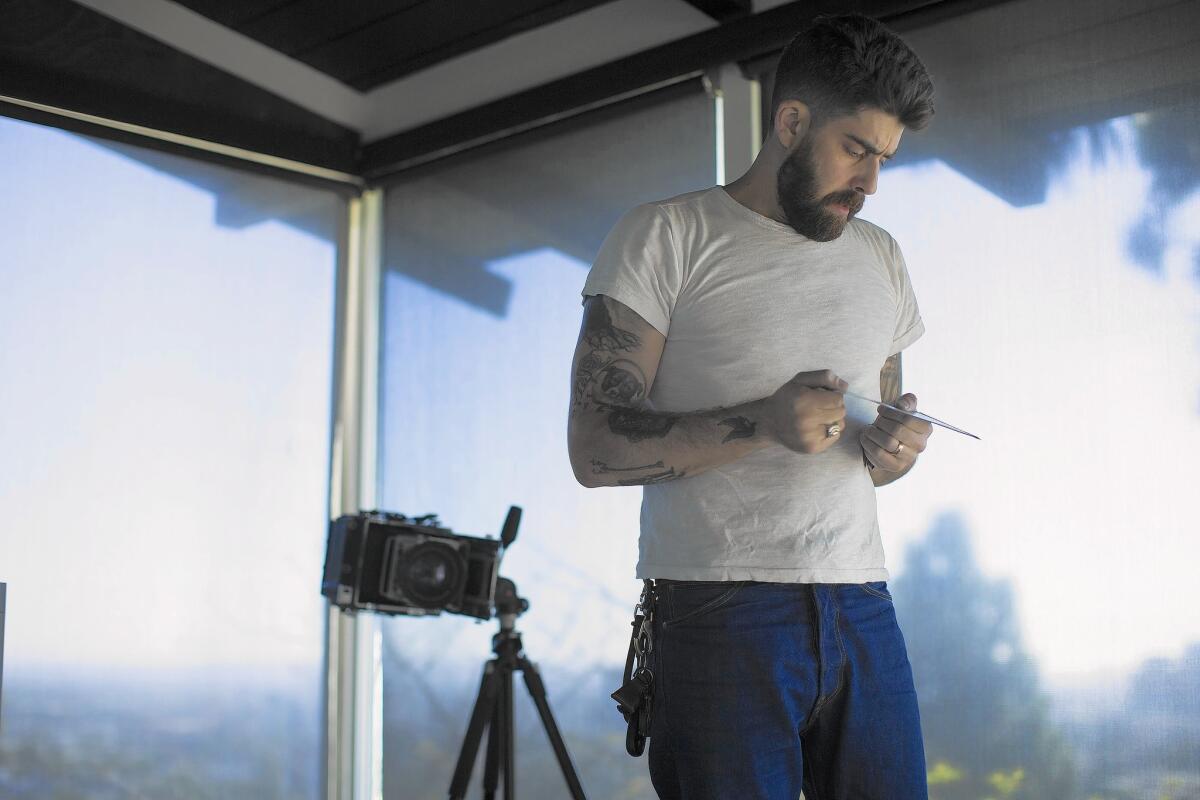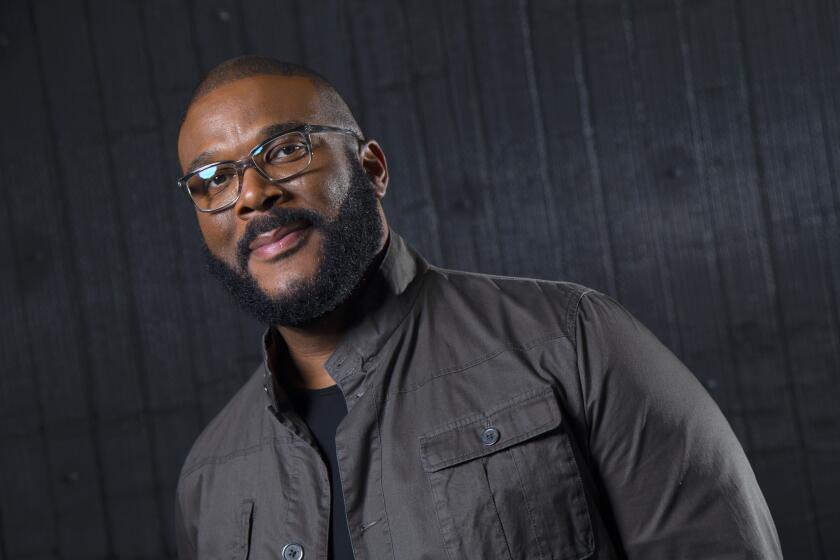Actor Adam Goldberg, of ‘The Jim Gaffigan Show,’ is an analog man living in a digital world

Adam Goldberg looks at a Polaroid after photographing his wife and a family friend with his 4 X 5 camera at his home on Sept. 29, 2015 in Los Angeles. He is very passionate about photography and still uses film cameras.
- Share via
Known for his nuanced, often neurotic character studies, the actor Adam Goldberg says his impulses toward self-expression roam far beyond the screen to music, writing, filmmaking and photography.
When it comes to this last obsession, Goldberg is a walking contradiction — an analog man living in a digital world. His fixation on vintage cameras and the visceral experience of taking photographs the old-school way is conflicted, as he turns to Instagram, Twitter and Tumblr to disseminate his pictures.
“The irony is that I’m taking 8-by-10 film and shrinking it down to the size of someone’s phone,” he says, shrugging. Another irony: Digital technology has made analog accessible and understandable to the modern masses.
SIGN UP for the free Essential Arts & Culture newsletter >>
“You can find incredibly obscure cameras and information and manuals online, so I’m constantly Googling and referring to those,” he says.
Goldberg costars on “The Jim Gaffigan Show” on TV Land and has three upcoming feature films — “Going Under” with Bruce Willis, “The Force” with Ben Feldman and the Netflix thriller “Rebirth.”
To work behind the lens, Goldberg retreats to his home office in the Hollywood Hills, where he has dozens of 20th century film cameras. There’s a 1950s Polaroid 900 Electric Eye Land Camera and a 1957 Asahi single-lens reflex Pentax. Representing the 1960s, ‘70s and ‘80s are Rolleiflex 2.8F in a sleek brown leather case, a Mamiya Universal, a medium-format Hasselblad and a Plaubel Makina. The things in this room are meticulously organized in stacked metal bins with neatly typed labels such as “Computer chargers & mice,” “Backup keyboards,” “Hard drive adapters & printer cables” and “Camera straps.”
“I’m a weird combination of anal retentive and anal expulsive,” he says while standing in front of a giant refrigerator crammed with film. Much of it has been discontinued, so Goldberg has searched for much of it online: 3.25-by-4.25 and 8-by-10 peel-apart instant film, 35-millimeter and 120-mm negative and transparency films, 3-by-5 integral and more.
Amid the sense of order are bins and folders so stuffed with photos that they seem about to explode in an ecstatic mess in all directions. This is the expulsive part of Goldberg’s personality and art: the paradoxical point where regulation meets — and briefly blends — with chaos.
Goldberg is 5-foot-11 and lanky, with wavy black hair and an oblong face that registers worry even when he’s cracking a joke. His arms are covered in tattoos, and he speaks so rapidly that it sometimes takes a while to catch up to his point. When you arrive, he has moved on to the next. His mind, it seems, never stops racing.
Perhaps that’s why he enjoys taking pictures on a 4-by-5 Graflex Speed Graphic camera with a ‘40s Aero Ektar lens, using a black viewing hood — like a Depression-era shutterbug — to block out light and to get the proper focus. It slows him down.
He demonstrates the process by taking a photo of his wife, Roxanne Daner, and their friend Kit Willesee, in his bedroom. He meticulously seats the women side by side on the bed and counts to three, after which the camera makes a loud clicking noise.
“Roxanne, stay exactly where you are. Kit, leave, please,” Goldberg says with the gravitas of a director on set. He is trying to pull off a double exposure, a process that calls for a lot of guesswork when using this kind of dated equipment and expired film.
He pushes the shutter button. There is a whir and a whiz, like the sound of Venetian blinds unfurling and slamming on a window sill with a shallow bang. A ripping noise comes next as Goldberg pulls the film out of its casing. The shot is way underexposed, and the women can barely be seen. The whole laborious process must be repeated, but next time it works. Almost half an hour has passed, and Daner flops back on the bed, relieved to no longer have to sit excruciatingly still.
“It’s extremely gratifying when something turns out,” says Goldberg, nodding contentedly at the photo sandwiched between his thumb and forefinger. “It’s a happy accident when the emulsion doesn’t spread evenly or the rollers are really dirty.”
Goldberg’s pictures are hazy and abstract, marked by the deep orange and yellow hues of analog warmth overlaid with the arcane trappings of analog imperfection. Dirty rollers that feed film through a camera create bright spots of light, like shiny stars on ankles or cheeks. Old emulsion — the light-sensitive coating on film — pools in thick pockets at the corner of frames. With focus deep and then shallow, double exposures add dream-like depth.
Anyone viewing his Instagram feed might get the feeling that these pictures are snapshots of Goldberg’s turbulent subconscious — a way to stop time. For the same reason, Goldberg prefers 35mm over digital when taking pictures of his 12-month-old son, Bud.
“It’s fun getting these shots back of Bud that look timeless and are of their specific moment,” he says. “Which is a weird contradiction since he’s very much of this digital moment.”
Goldberg pauses to think about this before pointing out that film pictures feel sentimental to him. They remind him of the way pictures of his own childhood look.
A community of people share Goldberg’s sentiments about the seemingly transient nature of digital ephemera. These people, with admitted irony, find one another online. They congregate under #filmisnotdead, #35mm, #filmcamera and more on Twitter and Instagram. They go on film shooting expeditions in various cities together.
Goldberg has more than 17,000 followers on Instagram and 19,000 followers on Twitter. Most of his posts are photographic or cinematic in nature. He does it for the love of the art form, and out of compulsion — the same kind of compulsion that pushed him to make Super 8 films as a teenager, his desk as littered with film then as it is with hard drives now.
In the late ‘90s and early 2000s, he kept journals that he pasted Polaroid pictures into. He says those journals don’t look radically different from his Tumblr. The only time he brushed with any sort of Internet fame, though, was in the early days of Vine when his auteur-like, six-second clips caught the attention of BlackBook magazine, which crowned him king of Vine in 2013. A slew of media attention followed.
“Why Vine?” Goldberg wonders. “Why did it take off?
“I thought maybe people could only tolerate my forms of expression and/or myself for six-second intervals.”
More to Read
The biggest entertainment stories
Get our big stories about Hollywood, film, television, music, arts, culture and more right in your inbox as soon as they publish.
You may occasionally receive promotional content from the Los Angeles Times.











